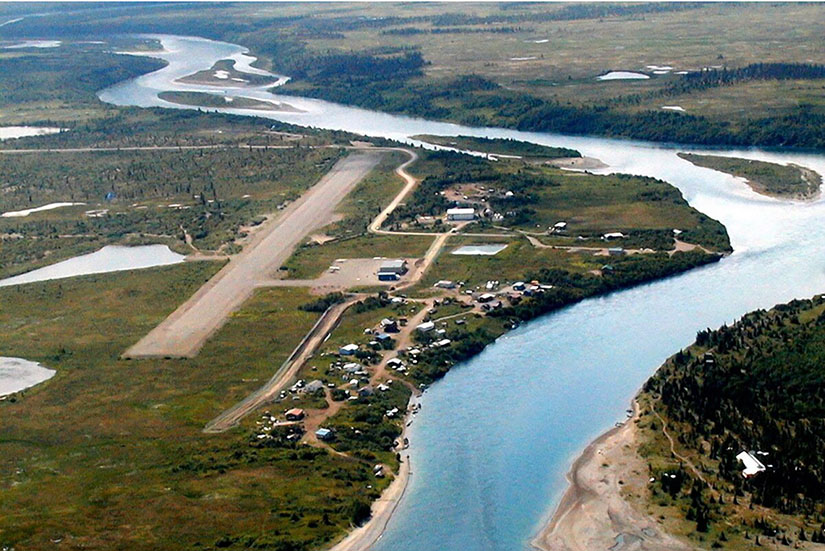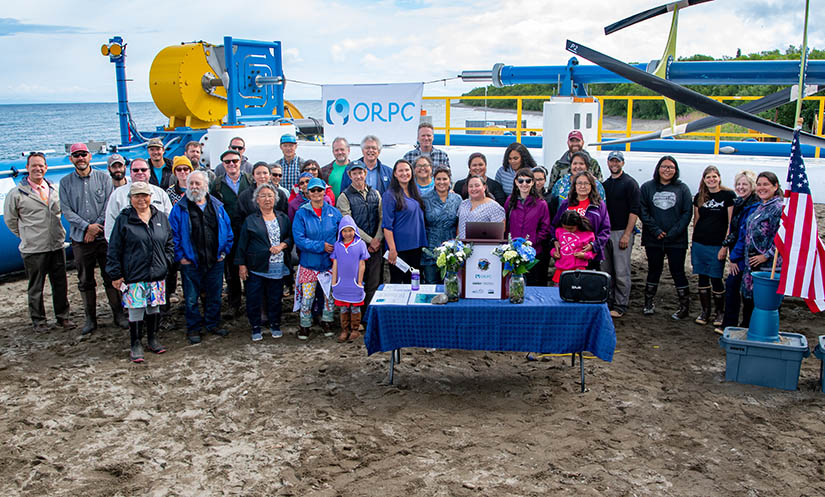An Alaskan Village's Journey Back to the Future
How Igiugig Plans To Fight for Their Clean, Independent Lifestyle With an Energy Overhaul
For the last 8,000 years, the Yup'ik Eskimos, Aleuts, and Athabascan Indians living in the remote Alaskan village of Igiugig have survived almost entirely off the land. Today, they hunt moose and geese and fish for salmon. They forage for cranberries and salmonberries (little roe-like clusters that are often used to make akutaq—Eskimo ice cream).
Back in the 1960s, the discovery of the country’s largest oil field in northern Alaska brought fuel and, with it, gasoline-powered vehicles and heating systems to Igiugig. But in the early 2000s, diesel fuel prices skyrocketed to $6.30 per gallon. Residents struggled to afford heat for their homes. Schools shuttered.
“It was a bleak picture with no end in sight,” said AlexAnna Salmon, the president of Igiugig’s village council. “And that’s when we sat down and said we need to do some strategic planning and address this.”
That is exactly what they did. In 2000, Igiugig drafted its first comprehensive plan for how to build a more sustainable community that ran primarily on renewable energy. Salmon, along with partners at the National Renewable Energy Laboratory (NREL) and Deerstone Consulting, finalized an updated comprehensive energy plan, which is summarized in a recently published case study, fittingly called Igiugig’s Journey to Sustainability.
Although this case study could just as easily be titled Igiugig’s Journey Back to Sustainability, the village’s nearly 70 residents are more concerned about the future. The impacts of a warming climate, including increased risk of wildfires, erosion, melting permafrost, as well as shifting harvests and wildlife migrations, threaten their traditional way of life.
“This lifestyle is why we’re living there,” Salmon said. “Everything that we operate and run is to feed that.”
From Oil to Currents
Most of Alaska still runs on oil: The state relies on fossil fuels for jobs and income as well as survival. Average winter temperatures in the state’s interior range from 20 to minus 10 degrees Fahrenheit.
But remote villages like Igiugig, which are disconnected from the state’s larger electric and road systems, must bring in oil by plane or barge. That extra transportation makes deliveries expensive and risky too. An oil spill could cripple Igiugig’s Kvichak River, their main source of drinking water and home to the largest salmon run in the United States. Both are essential to the village’s lifestyle.
And yet, another gift the Kvichak River offers—fast-moving currents—could help Igiugig reach its goal of reducing diesel consumption used for electricity by 50% by 2030.
“Becoming a test site was our best option,” Salmon said.
In 2019, with funding from the U.S. Department of Energy’s Water Power Technologies Office, Igiugig installed a tidal energy device in the river. The RivGen, built by Ocean Renewable Power Company, could generate enough energy to provide close to half the village’s electricity needs, Salmon said. But they were concerned whether the device, which is fully submerged in the Kvichak River and uses underwater turbines to harness river currents, might harm the fish that the villagers depend on.
“Over two seasons, we saw no impact to fish,” Salmon said, adding that she was ecstatic when this occurred during the salmon migration. “In a three-day period, 1.2 million salmon swam by the device.” Not one was harmed.

In 2021, Igiugig villagers and Ocean Renewable Power Company retrieved the first RivGen (to perform maintenance) and installed a second. But, despite tidal energy’s promise, this newer renewable energy device might need additional analysis to determine how the next iteration can support all of Igiugig’s needs.
The early-stage RivGen device is still relatively young—and therefore a bit riskier—than more established technologies. The Igiugig trial was one of the first long-term deployments of a river current device in the United States. Although two RivGen devices could help significantly reduce the village’s dependence on diesel, the technology must go through further testing before the people of Igiugig can rely on it to get them through their harsh winters.
To help the villagers assess all their energy options, both in the short and long term, the Water Power Technologies Office funded a collaboration between Igiugig, NREL, and Deerstone Consulting. Throughout 2021, a group of NREL researchers held virtual meetings with Igiugig community members (scheduling around salmon fishing, berry picking, and moose hunting) to evaluate their energy system.
“They’ve Tried Everything They’ve Got”
During one of those virtual meetings with Igiugig, Rebecca (Becki) Meadows, a senior engineer at NREL, told the villagers that her family recently took up salmon fishing. “In five minutes, they shared over a dozen amazing recipes for us to make the most of our winter supply,” Meadows said.
Together, Meadows, her colleagues, and Igiugig community members identified several high-priority steps that could help the village meet its diesel-reduction goals. One priority, for example, is to resolve high line-loss issues—in essence, the amount of electricity that is lost during transmission and distribution.
“The community is experiencing close to 15% line losses, and we are working to determine the cause,” said Meadows, who is one of the authors of Igiugig’s strategic energy plan.
The team is also working to ensure the community’s buildings are energy efficient. Although Igiugig has already weatherized more than 70% of its homes, Meadows and her NREL colleagues identified energy efficiency measures for several larger buildings that could help reduce the energy used by the clinic and the water pumphouse, in particular, helping reduce the village’s diesel consumption.

Yet another way to reduce diesel use is to install other renewable energy technologies, like solar panels and wind turbines. But the village might not need to install many if the RivGen devices perform well. Igiugig’s isolation also complicates that decision.
“Because of their remote location, they want to make sure that they can maintain whatever equipment is brought in,” Meadows said.
Igiugig villagers already boat out to the RivGen, pull it out of the water, and perform simple maintenance. But with help from NREL researchers, Igiugig assessed whether solar panels, larger wind turbines than those already installed in the village, and battery energy storage systems could help reduce their diesel use—and be maintained by local workers. A larger wind turbine, for example, could pair up with the RivGen devices to generate extra electricity and meet thermal energy needs. Currently, the villagers use more diesel for heating buildings than they do for electricity.
“What has made them successful is they’ve tried everything they’ve got,” said Levi Kilcher, a senior researcher at NREL and another author on the energy strategy. Kilcher, who helps advance marine energy technologies, like the RivGen, is excited about how much the NREL team has learned from Igiugig’s journey so far.
“We’ve learned a lot on the technical side already,” Kilcher said. “But I think there’s also a lot to learn from the community. How do they feel about all the work that is needed to operate and maintain the device? Is it too much compared to other options?”
"Igyararmiuni Ciunerkaput": Our Sustainable Future
Despite being a remote village of just under 70 residents, Igiugig’s journey to sustainability—its technology trials, snags, and successes—could help nudge the entire state toward a more sustainable future, Salmon believes.
“We now stand in a position to help inform our leaders on what works and what doesn’t and what is culturally and environmentally appropriate for the region that we’re in,” Salmon said.
Although Salmon welcomes external expertise and funding to launch their journey (they received support from the U.S. Department of Energy’s Energy Transitions Initiative Partnership Project in June 2022 to continue their clean energy transition), the village’s long-term goals are to achieve both energy security and economic sovereignty.
“We can’t keep looking to other people to solve our problems,” Salmon said. “From now on, we’re going to have to solve them ourselves.”
Learn more about NREL’s work to advance marine energy. And subscribe to the NREL water power newsletter, The Current, to make sure you do not miss a water power update.
Last Updated May 28, 2025
